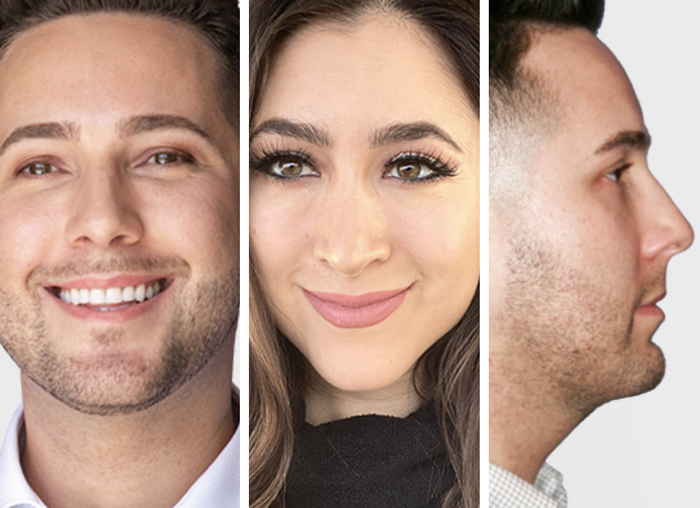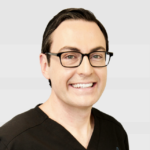Rhinoplasty is the surgical modification of the shape of the nose, also known as “nose job surgery” or nose reshaping. This procedure can be performed either “open” (using an external incision) or “closed” (using incisions only on the inside of the nose). The choice of approach is dictated by the specific goals of the patient, as well as any functional or anatomic issues which require a specific technique. In addition, most revision rhinoplasty (secondary rhinoplasty) requires an open approach due to the complex nature of this procedure and the need to provide internal support for the nasal structures (see Revision Rhinoplasty section). Septoplasty (fixing a crooked or broken septum) can be performed along with either an open or closed rhinoplasty.
Pairing Rhinoplasty with Other Procedures
Many men have thought about making a change to their nose, but have hesitated due to fears of looking feminine. As a rhinoplasty and nasal surgery specialist, Dr. Ransom understands the specific anatomical relationships, shapes, and facial proportions that make a nose look masculine or feminine. Most men who come in for a rhinoplasty consultation are interested in reducing the size of the nose – overall, or only certain parts (such as the bridge or “bump” and the nostrils). Dr. Ransom works closely with every patient to define the exact changes that are desired. This team approach helps him make sure that “you still look like you” after the procedure. For more details on specific approaches, please see the pages on open rhinoplasty and closed rhinoplasty or ethnic rhinoplasty for specific issues pertaining to non-Caucasian noses.
Explore our
Patient Gallery
*Actual patients in photos

After the procedure, you will wear a small plastic cast to protect the nose for up to a week. The nose will be sore, but pain is generally easily controlled. It is sometimes difficult to breathe for the first few days, due to swelling of the internal lining of the nose. However, Dr. Ransom does not use any nasal packing, and this allows the patient to breathe normally shortly after the surgery and significantly reduces postoperative discomfort. Contact sports must be avoided, though the length of time depends on the details of the surgery and will vary between patients. Please visit the photo gallery for examples.
Who is a candidate?
Anyone who wants to change the shape of their nose is a candidate for rhinoplasty. For men who want a minimal change, predominantly in the middle and upper part of the nose (nasal bridge), a closed approach may be possible. Patients with a crooked nose, a history of nasal trauma (for example, an untreated fracture), or significant functional concerns (breathing problems), are better served with an open approach. Finally, patients who have had a previous rhinoplasty or who have complex structural issues in the middle part or tip of the nose, are best treated with an open rhinoplasty. Contraindications for rhinoplasty include an active nasal infection, ongoing narcotic use (intranasal cocaine), and any active autoimmune disease or vasculitis. As a nasal surgery specialist, Dr. Ransom is concerned about the overall health of the nose and your breathing, in addition to the shape and proportions of the nose. During your confidential consultation, Dr. Ransom will review your medical history and examine both the internal and external portions of your nose, to ensure that the right procedure is performed for your unique situation.
Frequently Asked Questions
Please note that all patients are different and individual healing times and results may vary. The statements regarding procedures and recovery made here are general rules.
In most cases, you will have a cast on the nose for about a week after the procedure. This helps to protect the nose from accidental trauma, and also stabilizes the bones during the initial healing phase. No packing is used in the nose, which makes recovery much more comfortable. Your nose may feel “stuffy” for a few days, but this resolves quickly. Pain is minimal. You will likely feel tired for a couple days and should limit your activities and concentrate on resting and recovery. Contact sports, racket and ball sports, heavy lifting, and straining must be avoided until Dr. Ransom gives you the “okay” – this is typically a couple weeks.
For most patients, the initial recovery is quick – typically a week. Due to swelling inside the nose, many patients feel “stuffed up” for a few days. Bruising is limited, though some swelling will occur throughout the nose. Much of this resolves over the first week, but some swelling will persist after that and may take longer to go away completely. Pain is minimal and Dr. Ransom does not use nasal packing, making recovery more comfortable for his patients. Most plastic surgeons agree that the final result of a rhinoplasty is not seen for at least six months, and it is common to see subtle changes up to a year from the surgery.
During the healing phase after your procedure, there will be swelling inside the nose. This takes some time to resolve, and may cause a temporary sensation of blockage or “stuffy” nose. After the swelling resolves, there should not be any changes to your breathing. In fact, Dr. Ransom is a nose specialist and uses this knowledge to make sure that his patients’ breathing is not negatively affected by nose reshaping. In some cases where the septum is crooked or functional issues (difficult nasal breathing) exist before surgery, Dr. Ransom can actually improve the breathing during your rhinoplasty. Any issues pertaining to breathing can be discussed during your consultation.
Dr. Evan Ransom is an Ivy League-educated and Ivy League trained Facial Plastic and Reconstructive Surgeon. He is a Double Board Certified Head and Neck Surgeon and Facial Plastic and Reconstructive Surgery and fellowship-trained in facial plastic, reconstructive, and laser surgery. His practice is in the San Francisco Bay Area, serving patients from San Francisco, Oakland, Marin County, Palo Alto, Silicon Valley, Walnut Creek, the East Bay, and all over Northern California.
 (415) 550-1077
(415) 550-1077 San Francisco
San Francisco

 Play Video
Play Video


